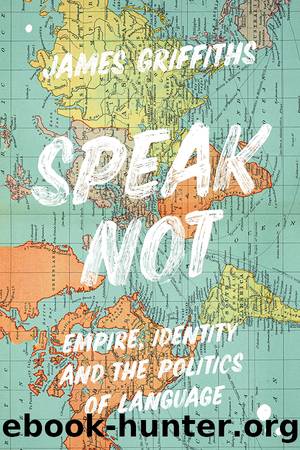Speak Not by James Griffiths

Author:James Griffiths [Griffiths, James]
Language: eng
Format: epub
Publisher: Bloomsbury
PART THREE
Cantonese
Gwóngdūng wá
Language family
Sino-Tibetan
â Sinitic
â Yue
â Cantonese
â Mandarin
â Putonghua
Cantonese is a Sinitic, or Chinese, language of the Yue family. Like other major branches of Chinese, including Mandarin and Wu, Yue is descended from Middle Chinese, a language spoken during the fourth century. Today, all three branches have diverged significantly, and are not mutually intelligible. While many Chinese languages are often described as âdialectsâ in English, this is a mistranslation of the Chinese term fangyan, literally âlanguage of a placeâ or topolect. Cantonese is not a dialect any more than Mandarin is, rather both are languages within the Chinese family. Confusion arises as many actual dialects, such as different varieties of Mandarin, have large speaker bases in China, and because for political reasons, only the official tongue of Putonghua is given the descriptor âlanguageâ by the Chinese government.
Speakers
Hong Kong: ~7 million
Worldwide: ~73 million (primarily in Guangdong, China; Hong Kong; Macao; Malaysia; Canada)
Writing system
Standard Written Chinese (, syūmihnyúh), using traditional Chinese characters and a grammar closer to Putonghua than spoken Cantonese. Vernacular Cantonese is also written in both Chinese characters and the Latin alphabet.
Distinctive features
Cantonese has six tones compared to Putonghuaâs four, and also preserves the yahp sÄ«ng, or checked tone, where words end in plosive consonants, a feature not seen in Putonghua and other Mandarin dialects. Examples are the numbers yÄt (1), luhk (6), chÄt, (7), and baat (8), where the final consonant is clipped, similar to the middle letters of âbutterâ when said in a Cockney English accent: âbuâerâ. Grammatically, spoken Cantonese also differs from Putonghua, for example in the use of direct objectâindirect object word order rather than indirect objectâdirect object, âgive water meâ in Cantonese, instead of âgive me waterâ in Putonghua.
Examples
Iâm a Hong Konger, I speak Cantonese.
Ngóh haih HÄung Góng yà hn, ngóh sÄ«k góng GwóngdÅ«ng wá.
Where is the toilet?
Chisó hái bīndouh a?
How much is this egg tart?
NÄ« go daahn tÄat géi chìhn a?
Download
This site does not store any files on its server. We only index and link to content provided by other sites. Please contact the content providers to delete copyright contents if any and email us, we'll remove relevant links or contents immediately.
How to Be a Bawse: A Guide to Conquering Life by Lilly Singh(7393)
Spare by Prince Harry The Duke of Sussex(5072)
Millionaire: The Philanderer, Gambler, and Duelist Who Invented Modern Finance by Janet Gleeson(4376)
Machine Learning at Scale with H2O by Gregory Keys | David Whiting(4183)
Never by Ken Follett(3791)
Harry Potter 02 & The Chamber Of Secrets (Illustrated) by J.K. Rowling(3622)
The Heroin Diaries by Nikki Sixx(3495)
Urban Outlaw by Magnus Walker(3342)
Harry Potter and the Prisoner of Azkaban (Book 3) by J. K. Rowling(3304)
Fairy Tale by Stephen King(3220)
Japanese Design by Patricia J. Graham(3110)
The Man Who Died Twice by Richard Osman(2997)
The Club by A.L. Brooks(2862)
Stacked Decks by The Rotenberg Collection(2812)
Will by Will Smith(2793)
Harry Potter and the Deathly Hallows (7) by J.K. Rowling(2642)
Churchill by Paul Johnson(2506)
The Chimp Paradox by Peters Dr Steve(2298)
Borders by unknow(2229)
